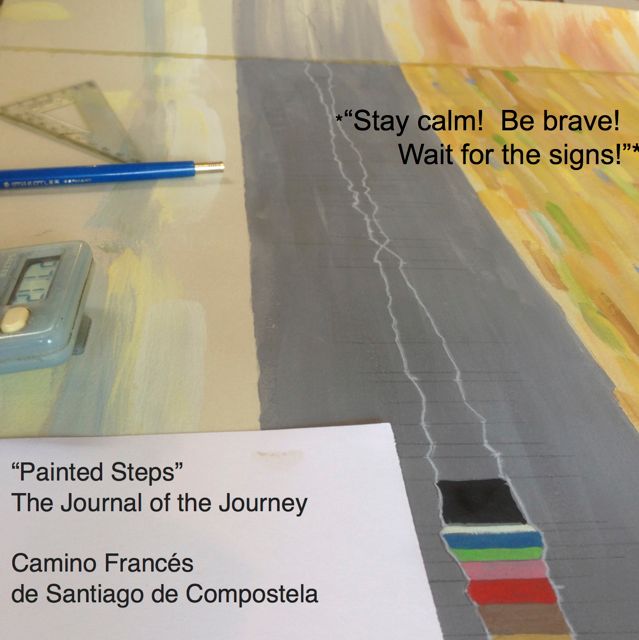|
A Spiritual Journey -The Camino de Santiago as a metaphor, metaphor as a spiritual tool, art making as the Path. In the Pyrenees foothills, just before the steep descent into the town of Zubiri, along what Alain & I call Dinosaur Ridge, this little creature crossed our path. We paused and watched him/her inch, crawl, slither, moonwalk, travel up and across the gravely path in the direction of Santiago. Much smaller than us, much, much slower, but going just as fast and far in it’s own way. This beautiful creature (in all its manifestations) would accompany us through Navarra, the vineyards of Rioja, over the karst hills of Atapuerca, past the fields of ripening wheat barley oats peas, up the climb onto the Meseta across the blazing Terra de Compos, and into León. We chose the el Caracol as our ‘spirit animal” to guide our walk. The Grove snail is a ‘good’ snail, does no harm to the agricultural growth. It’s ‘grounded’; walks solid every step of the way, one step (with one foot) at a time, never jumping over the hard parts. As it’s namesake ‘snail mail’, it’s a metaphor for real, not virtual or alternate real. Real real, here & now, physical, real. And according to the science “they have excellent associative thought which helps them remember the places where they were or where the objects of their surroundings are” - a wonderful trait for our Camino journey, and for the art-making journey of Painted Steps. You see this sign on posts and walls in the pueblos and towns along the Camino. It means here is post office for your postcards back home. Peregrinos are encouraged to take a weight off their backs – sort through their back packs, mochilas, box up their unnecessary baggage, and mail it home. In the big main post office in Burgos we saw a number of people taking this advice. There are special large boxes for bicycles. From the corner of my eye, at a quick glance I always read the logo as a snail - maybe not the desired association! Snail reminds us to GO SLOW Stay calm, Look for the signs… Camino Miracles My first ‘Camino miracle’ occured in St Jean Pied-de-Port on the eve of our departure into Spain, our last night before we hit the trail. We were on a terrace enjoying this delicious dinner, something with meat and oranges, and we struck up a conversation with a fellow at the next table whom we thought might be a pilgrim which he turned out to be. A youngish Swiss man, he told us he had been walking for weeks, having started the Camino in Le Puy-en-Velay, near Lyon, in France over 700 k away. He was having a short stay in St Jean before continuing towards Santiago. He was still enjoying himself and was happy to answer our somewhat anxious questions. He generously offered us our first piece of on-the-trail advice: Stop every two hours, take off your shoes and socks and dry them out, rest. Trust me. And we did. For the next 500k, every two hours we allowed ourselves to stop walking, to sit down, take off our shoes/boots. Sometimes we had a bite to eat, paddled in a stream, made drawings, prints, lay in the grass (or dirt or rock), had a siesta! This way we avoided making blisters, infections, pain, misery, slogging, boredom and using pharmaceuticals. It is a great piece of advice! The miracle is that we took it! Thank you, our first peregrino, like our spirit animal, showing us how not to be in a rush to get there. P.S. Interesting ‘facts about Grove snail - Caracole de la arboleda (from wiki) The grove snail or brown-lipped snail (Cepaea nemoralis) is a species of air-breathing land snail, a terrestrial pulmonate gastropod mollusc.
It is among the largest and, because of its polymorphism and bright colours, one of the best-known snails in Western Europe. The width of the shell is 18–25 mm. The height of the shell is 12–22 mm. with from 4½ to 5½ whorls. This snail is comparatively slow-growing, usually taking three years to develop from an egg to a breeding adult. It is used as a model organism in citizen science projects.[4] Cepaea nemoralis predominantly moves in an upwind direction. They first randomly move in any direction before following the upwind stream. The decision to move upwind is made when the odor of favored foods is detected. Those dots are their tentacles /antlers are eyes. They can move their tentacles up or down to improve their ability to see. The sense of sight of snails is useful but only to detect changes in the intensity of light to recognize whether it is night or day They are practically deaf since they have no ears nor ear canal. To compensate this absence of hearing they have an excellent associative thought which helps them remember the places where they were or where the objects of their surroundings are.
0 Comments
|




 RSS Feed
RSS Feed